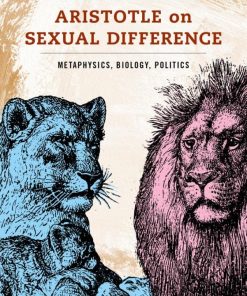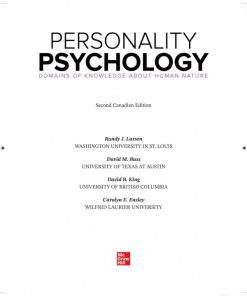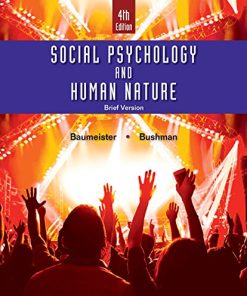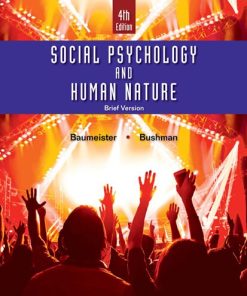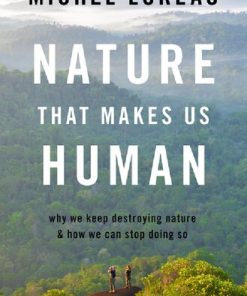(EBOOK PDF)On Human Nature Biology Psychology Ethics Politics and Religion 1st edition by Academic Press 9780127999159 0127999159 full chapters
$50.00 Original price was: $50.00.$25.00Current price is: $25.00.
On Human Nature Biology Psychology Ethics Politics and Religion 1st edition by Academic Press – Ebook PDF Instant Download/Delivery: 9780127999159, 0127999159
Full download On Human Nature Biology Psychology Ethics Politics and Religion 1st edition after payment
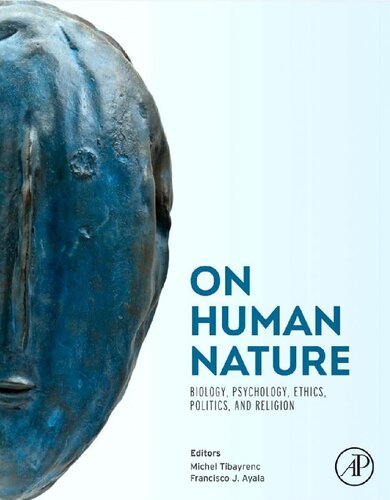
Product details:
• ISBN 10:0127999159
• ISBN 13:9780127999159
• Author:Academic Press
On Human Nature
Biology, Psychology, Ethics, Politics, and Religion
On Human Nature: Biology, Psychology, Ethics, Politics, and Religion covers the present state of knowledge on human diversity and its adaptative significance through a broad and eclectic selection of representative chapters. This transdisciplinary work brings together specialists from various fields who rarely interact, including geneticists, evolutionists, physicians, ethologists, psychoanalysts, anthropologists, sociologists, theologians, historians, linguists, and philosophers.
Genomic diversity is covered in several chapters dealing with biology, including the differences in men and apes and the genetic diversity of mankind. Top specialists, known for their open mind and broad knowledge have been carefully selected to cover each topic. The book is therefore at the crossroads between biology and human sciences, going beyond classical science in the Popperian sense.
The book is accessible not only to specialists, but also to students, professors, and the educated public. Glossaries of specialized terms and general public references help nonspecialists understand complex notions, with contributions avoiding technical jargon.
Provides greater understanding of diversity and population structure and history, with crucial foundational knowledge needed to conduct research in a variety of fields, such as genetics and disease
Includes three robust sections on biological, psychological, and ethical aspects, with cross-fertilization and reciprocal references between the three sections
Contains contributions by leading experts in their respective fields working under the guidance of internationally recognized and highly respected editors
On Human Nature Biology Psychology Ethics Politics and Religion 1st Table of contents:
Part I. Biological Basis of Human Diversity
Chapter 1. The Advent of Biological Evolution and Humankind: Chance or Necessity?
Chance and Necessity
Epigenetic Processes
What Is a Hominin?
Human Similarities and Differences
The Distinctive Features of Humans
Chance and Necessity in Human Evolution
Can Adaptive Advantages of Bipedalism Be Identified?
“Partial” Versus “Complete” Bipedalism
The Two Adaptive Advantages of Bipedalism
The Origin of Modern Humans
Chapter 2. Hominins: Context, Origins, and Taxic Diversity
Hominins Located in the Tree of Life
Candidates for the Stem Hominin
Assessing the Claims for Hominin Status
Ladder or Bush?
Evidence of Taxic Diversity Within the Hominin Clade
7.0–5.0 Ma
5.0–4.0 Ma
4.0–3.0 Ma
3.0–2.5 Ma
2.5–2.0 Ma
2.0–1.5 Ma
1.5–1.0 Ma
1.0–0.25 Ma
0.25 Ma to the Present
Discussion
Conclusions
Chapter 3. The History of Early Homo
The First Homo
The Discovery of Homo erectus
Dmanisi
Hominins
Paleoenvironment
Stone Tools
Post–Homo erectus Evidence
Hobbit
Conclusion: What We Learned from the Dmanisi Case
Chapter 4. The Contribution of Genetic Ancestry From Archaic Humans to Modern Humans
Models of Human Origins
Other Archaic Human Genomes
Archaic Genomes and Modern Human Dispersals
Archaic Genomes and Selection
Concluding Remarks
Chapter 5. World Dispersals and Genetic Diversity of Mankind: The Out-of-Africa Theory and Its Challenges
Introduction
Phylogeography and Models of Human Evolution
Fossils, Archaeology, and Models of Human Evolution
Implications of Recent Human Evolution for Current Patterns of Human Genetic Diversity
Summary and Conclusions
The Evolutionary and Genetic Unity of the Human Species
Chapter 6. Human Population Variability and Its Adaptive Significance
A Mankind Population Genetics Framework for Applied Research
Rarity Matters: Rare Variants and Low Frequency Variants
Copy Number Matters: Structural Variation
Not Only Genes: Regulation Is a Major Actor
What About Phenotypic Geographical Variation?
Abundant Indications for Recent and Geographically Differentiated Evolution
Conclusion
Glossary of Specialized Terms
Chapter 7. Evolution and Implications of Genomic Diversity on “Human Kind” in India
Introduction
Peopling of India
Implications in Health and Disease
India: Grandest Experiment of Nature
Conclusion
Chapter 8. The Human Brain: Evolution and Distinctive Features
Introduction
Some Basic Neuroanatomy
Themes and Theories in Human Brain Evolution
Evolution of Brain Size and External Morphology
Internal Changes
Molecular Specializations Relevant to Human Brain Evolution
Conclusions
Chapter 9. How Different Are Humans and “Great Apes”? A Matrix of Comparative Anthropogeny
The Challenge of Comparative Anthropogeny
Our Evolutionary Heritage and Primate Nature
Comparative Anthropogeny
Matrix of Comparative Anthropogeny
Selected Examples of Comparative Anthropogeny
Topic Timelines and Relationships
Generating Networks of Relationships Among Matrix of Comparative Anthropogeny Topics
Synthesis With Existing Theories of Human Origins
Caveat: Absence of Evidence in Nonhuman Primates Is Not Evidence for Absence
Moving the Goalposts
Conclusions and Future Prospects
Chapter 10. Human Intergroup Variation and Disease Genetics
Introduction
Brief Review of Population Structure and Recent Evolution in Humans
Looking for Disease Genes: Candidate Genes, GWAS, WGS; CD/CV, RV
Mendelian Diseases Around the World
Geographical Distribution of Complex Diseases
Transmissible Diseases, Still the Main Factor of Natural Selection in Humans
Inflammatory and Autoimmune Diseases: The Hygiene Hypothesis
Resistance Alleles
Concluding Remarks
Glossary
Chapter 11. Natural Selection Associated With Infectious Diseases
Infectious Diseases and Human Evolution
Detecting Natural Selection in the Human Genome
Signatures of Pathogen-Driven Natural Selection in the Human Genome
Evolutionary Causes of Susceptibility to Infectious Diseases
Future Perspectives
Chapter 12. Aging, Somatic Evolution, and Cancer
Multicellularity and Somatic Evolution
Organismal Fitness Versus Stem Cell Fitness
Aging and Somatic Evolution
Evolutionary Strategies for Cancer Suppression
Tissue Organization and Tumor Suppression
Evolutionary Understanding of Cancer: An Imminent Paradigm Shift
Chapter 13. Evolution of the Human Leukocyte Antigen System
Introduction
Competing Evolutionary Pressures: HLA–NK Cell Interaction
Future Considerations
Conclusions
Chapter 14. Human Life History Evolution: New Perspectives on Body and Brain Growth
Introduction
Mammalian Patterns
Primate Patterns
Humans
Brain Evolution
Gene Expression
APOE Alleles
Prospectus
Chapter 15. Gorillas in Our Midst? Human Sexual Dimorphism and Contest Competition in Men
Introduction
Strength of Sexual Selection in Men
Selection for Male Contests
Alternatives to Male Contests
Conclusion
Chapter 16. The Human Family: Evolutionary Origins and Adaptive Significance
Brain, Childhood, and Family
The Human Family
Neurological and Physiological Mechanisms
Summary and Concluding Remarks
Chapter 17. Biological Future of Humankind: Ongoing Evolution and the Impact of Recognition of Human Biological Variation
Basic Principles of Human Adaptation
Recent Change of Human Ecology
Structural Reduction of Human Morphology
Changes in Body Height
Changes of Anatomical Structures
Changes in Natural Selection
Gene Flow Increasing Variation in Populations
Coevolution of Humans and Pathogens
Adaptations at the End of Life
Miscarriage Rate and Maternal Age as Influencing Factors
Influence by In Vitro Fertilization
Influences of Changes in Family Structure
Changes in Health and Disease Definition as a Consequence
Part II. Psychology, Behavior and Society
Chapter 18. Gene-Culture Models for the Evolution of Altruistic Teaching
Introduction
Basic Haploid Model with Asexual Reproduction and Uniparental Transmission (ARUT)
Haploid Model with Sexual Reproduction and Biparental Transmission (SRBT)
Adding Oblique Transmission
Adding Horizontal Transmission (VTHT)
Discussion
Appendices
Chapter 19. Multiple Origins of Agriculture in Eurasia and Africa
Introduction
The Terminology Conundrum
The Social Contexts of Cultivation and Domestication Emergence
Animal Domestication
Pathways to the Domestication of Plants
Intra and Interregional Connections
The Centers for Plant Cultivation and Domestication
The Spread of Agriculture to the “Noncenters” and Its Impacts
Brief Review of the Americas
Discussion
Chapter 20. The Quantum Origin of Life: How the Brain Evolved to Feel Good
Introduction: Which Came First, Feelings or the Brain?
Consciousness on the Edge Between Quantum and Classical Worlds
Life in the Quantum Underground
Microtubules and Sex in the Primordial Soup
Conclusion: Did “Quantum Feelings” Spark the Origin and Evolution of Life?
Chapter 21. Empathy, Theory of Mind, Cognition, Morality, and Altruism
Introduction
Neuroscience and Dynamics of Empathy
Theory of Mind (ToM)
The Relationship Between Empathy, ToM, Morality, and Other Neural Networks
The Mesolimbic and Cortical Systems and Their Relationship With Altruism
What Is Altruism? (Hint: It’s not Necessarily What It Looks Like)
The Problem With Prosociality
Harmful Prosocial Behavior
Altruism Through Evolution to Today
Chapter 22. Cognitive Ethology and Social Attention
Introduction
Cognitive Ethology
Cognitive Ethology: Lab to Life
Cognitive Ethology: Life to Lab
Summary
Concluding Comments
Chapter 23. Human Sociobiology and Group Selection Theory
What Is Human Sociobiology?
The First Wave of Criticisms of Sociobiology
Kin Selection and Human Sociobiology
Group Selection and Human Altruism
Why Have Wilson’s Views on the Importance of Multilevel Selection Been Largely Ignored by Evolutionary Biologists?
What About Humans?
Conclusion
Chapter 24. Behavior Analysis, Darwinian Evolutionary Processes, and the Diversity of Human Behavior
Population Thinking
Darwinian Evolutionary Process
Evolutionary Explanations of Behavior
Conclusion
Chapter 25. A Psychoanalyst Views the Self Across Civilizations
Prologue
The Social and Cultural Contexts of the Familial Self
The Familial Self
The Magic Cosmic and Spiritual Self
Social and Cultural Contexts of Western Individualism
Epilogue
Chapter 26. Biological and Social Causation of Serious Mental Illness
Diagnosing Mental Illness
Theories of Etiology
Mental Illness and Biology and Environment
Chapter 27. The Flexible Psychological Concept of Normality
Part One
Part Two
Chapter 28. Diversity and Hierarchy in the Evolution of Mental Mechanisms
Introduction
Evo-Devo and Descent With Modification in the Brain
Classical Versus Hierarchical Modularity
Most of Human Nature Is Not Human Specific
Much of Human Uniqueness Arises in Part From Non-Uniquely Human Mechanisms
Part of Human Uniqueness Must Lie in Uniquely Modified Interactions
Evolutionary Feedback as a Missing Ingredient
Conclusion
Chapter 29. Human Diversity at the Individual and Population Levels, and Societal Hierarchies
Introduction
Hierarchies and Dominance in the Animal Kingdom
Do Humans Have Hierarchies?
Uniquely Human Social Cognition
How Our Ancestors Challenged Hierarchies
Why Hierarchies Are Functional
From Cooperative to Exploitative Hierarchies
Conclusion
Chapter 30. Homosexuality and Evolution: A Critical Appraisal
Introduction
Extent of Homosexuality
Substance of Homosexuality
Function of Homosexuality
Summary
Chapter 31. The Roots and Individual Diversity of Addiction
Introduction
Addictive Behavior in Humans Throughout History
Roots of Reinforcement and Motivation in Addiction
Dissecting Addictive Behavior: Approaches to Measure Reward and Addictive Phenotypes in Humans and Animals
The Diversity in Transition to Addiction: Vulnerability Factors
Concluding Remarks
Chapter 32. Human Variability and the Origins and Evolution of Language
Introduction
Levels of Relaxed Selection
Relaxed Selection and Brain Evolution
Conclusions and Possible Implications
Chapter 33. Human Evolution and Progress
Introduction
The Ladder of Life
The Idea of Progress
Definition of Progress
Kinds of Progress
Progress as a Biological Concept
Is Evolution Universally Progressive?
Evolutionary Progress
Progress and Human Consciousness
Concluding Remarks
Chapter 34. Culture, Brain, and Behavior: The Implications of Neural Plasticity and Development on Social Contexts and Political Structures
The Interaction of Brain and Culture
Genetic Predispositions and Motivational Drives
Cultural Practices and Long-Term Effects on Gene Expression and Epigenetic Processes
Interaction of Culture and Development
Conclusion
Part III. Ethics, Politics and Religious Considerations
Chapter 35. Adaptive Significance of Ethics and Aesthetics
Introduction
Darwin and the Moral Sense
Moral Behavior Versus Moral Norms
Darwinian Aftermath
Moral Behavior as Rational Behavior
Conditions for Ethical Behavior
Adaptation or Exaptation?
Altruism and Group Selection
Whence Moral Codes?
Sociobiology’s Account of Moral Behavior
Altruism: Biological and Moral
Gene–Culture Coevolution
Aesthetics
Oldowan and Acheulean Cultures
Mousterian Culture and Neandertals
Symbolism and Aesthetics: Aurignacian and Magdalenian Cultures
Chapter 36. The Politics of Human Nature
Introduction
Dehumanization
Evidence From History, Cultural Anthropology, and Social Psychology
Two Forms of Dehumanization, From Explicit to Implicit
Functional Perspective Necessary
Conclusion and Outlook
Chapter 37. The Race/Ethnic Debate: An Outsider’s View
Where Are We Now: Human Genetic Diversity in Light of Modern Genomics
The Taxonomical Problem: Are There “Races”?
Is Race a Social Construction?
The Fst Argument
Discrepancies?
Homogeneity and Boundaries
So, How Many Races Are There (if Any)?
Races, Subspecies, and Species in Animals
Semantic Caution: A Headache
Censorship?
Two Different Strategies to Fight Racism
Chapter 38. Social Darwinism
Charles Darwin
Social Views
Herbert Spencer
Points to Consider
Adolf Hitler
Julian Huxley
Edward O. Wilson
Conclusion
Chapter 39. History and Diversity of Religion
Religious Versus Nonreligious
The Problem of Defining
Defining Religion
Classifying Religion as a Project of Secular Modernity
The Development and Use of “Religion” in East Asia in the 19th and 20th Centuries
Concluding Thoughts
Chapter 40. Religion Viewed From Different Sciences
What Is Science and What Is Religion?
There Would Be No Room for Religion, if Science Covers All There Is
There Would Be No Room for Religion if There Is Only “Matter” in This Universe
There Would Be No Room for Religion if Science Can Explain Religion Away
There Would Be No Room for Religion if We Go by the “Hard” Facts
How Do We Get to the Facts?
Is There a Way for Science and Religion to Live Together?
Chapter 41. Universal Humanity, Religious Particularity, and Scientific Reductionism
The First Gap: Consciousness in the Context of Neuroscience and Neurophilosophy
The Second Gap: Religion in the Context of Sociobiology’s Account of Evolution
The Third Gap: Big History as the Comprehensive Context
From Beyond Nature and History: The Axial Breakthrough
Conclusion
Chapter 42. Evolution and the Future of Medicine
Introduction
The Idea of Evolutionary Medicine
An Evolutionary Perspective on Genomic Medicine
A Hamiltonian Approach to the Chronic Diseases of Aging
Strategies for Pharmaceutical Development
Conclusion: A Fourth Re-Visioning of Medicine
Chapter 43. The Impact of Modern Medicine on Human Evolution
Introduction
Eugenics
The Impact of Modern Medicine on Human Evolution
Conclusion
Chapter 44. Science and Technology in Human Societies: From Tool Making to Technology
Tool Making
Precultural Uses of Tools
Taphonomic Indications of Culture
Mode 1: Oldowan Culture
The Transition Mode 1 (Oldowan) to Mode 2 (Acheulean)
The Acheulean Technique
Culture and Dispersal
An Ancient Mode 2 in Asia?
The Transition Mode 2 (Acheulean) to Mode 3 (Mousterian)
Neandertals and Mousterian Culture
The Transition Mode 3 (Mousterian) to Mode 4 (Aurignacian)
The African Middle Stone Age
The Protagonists of the South African MSA
The Way Out of Africa for Homo sapiens
Transitional Industries
Chapter 45. Biology, Psychology, Ethics, and Politics: An Innate Moral Sense?
The Original Moral Sense Theory
Contemporary Evidence of a Moral Sense
Moral Psychology and Neuroscience
Conclusion
Chapter 46. What HIV Has Taught About the Interactions Between Biology, Culture, and Other Evolving Systems
The Interaction of Evolutionary Systems
Antiretroviral Therapy in Treatment and Prevention
Cultural and Political Context and Response to HIV
Size of the HIV Epidemic
Current Targets and Priorities to Control the HIV Epidemic
What Can Be Learned From Our Response to HIV?
Index
People also search for On Human Nature Biology Psychology Ethics Politics and Religion 1st:
on human nature. biology, psychology
on human nature biology psychology ethics politics and religion
what is human nature in psychology
human nature explained
human nature explanation
Tags:
On Human Nature,Religion Michel Tibayrenc,Academic Press
You may also like…
Politics & Philosophy - Ancient & Medieval Philosophy
Aristotle on Sexual Difference: Metaphysics, Biology, Politics
Business & Economics - Responsibility and Business Ethics
The Ethics of Killing: Life, Death and Human Nature 1st Edition
Politics & Philosophy - Philosophical Positions & Movements
Politics & Philosophy - Anthropology
Politics & Philosophy - Anthropology
Politics & Philosophy - Social Sciences
Social Psychology and Human Nature, Brief 4th Edition Baumeister




